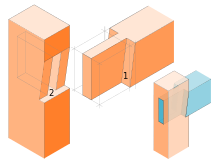
Back Caixa i metxa Catalan Tapsamling Danish Zapfenverbindung German Σύνδεσμος μόρσου - εγκοπής Greek Mortezo kaj tenono Esperanto Caja y espiga Spanish Tapp (tisleritöö) Estonian Aho-zirika Basque مورتیس و تنون Persian Mortaise (menuiserie) French



A mortise and tenon (occasionally mortice and tenon) joint connects two pieces of wood or other material. Woodworkers around the world have used it for thousands of years to join pieces of wood, mainly when the adjoining pieces connect at right angles.
Mortise and tenon joints are strong and stable joints that can be used in many projects. They connect by either gluing or friction-fitting into place. The mortise and tenon joint also gives an attractive look. One drawback to this joint is the difficulty in making it because of the precise measuring and tight cutting required. In its most basic form, a mortise and tenon joint is both simple and strong. There are many variations of this type of joint, and the basic mortise and tenon has two components:
- the mortise hole, and
- the tenon tongue.
The tenon, formed on the end of a member generally referred to as a rail, fits into a square or rectangular hole cut into the other, corresponding member. The tenon is cut to fit the mortise hole exactly. It usually has shoulders that seat when the joint fully enters the mortise hole. The joint may be glued, pinned, or wedged to lock it in place.
This joint is also used with other materials. For example, it is traditionally used by both stonemasons and blacksmiths.
© MMXXIII Rich X Search. We shall prevail. All rights reserved. Rich X Search